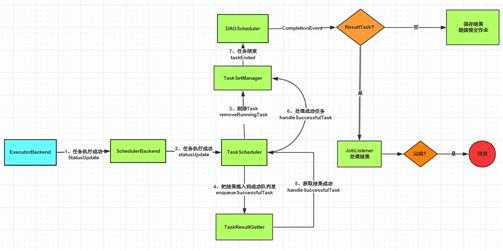标签:
上一小节《任务执行机制和Task源码浅析1》介绍了Executor的注册过程。
这一小节,我将从Executor端,就接收LaunchTask消息之后Executor的执行任务过程进行介绍。
DriverActor提交任务,发送LaunchTask指令给CoarseGrainedExecutorBackend,接收到指令之后,让它内部的executor来发起任务,即调用空闲的executor的launchTask函数。
下面是CoarseGrainedExecutorBackend中receiveWithLogging的部分代码:
case LaunchTask(data) =>
if (executor == null) {
logError("Received LaunchTask command but executor was null")
System.exit(1)
} else {
val ser = env.closureSerializer.newInstance()
val taskDesc = ser.deserialize[TaskDescription](data.value)
logInfo("Got assigned task " + taskDesc.taskId)
executor.launchTask(this, taskId = taskDesc.taskId, attemptNumber = taskDesc.attemptNumber,
taskDesc.name, taskDesc.serializedTask)
}Executor执行task:
def launchTask(
context: ExecutorBackend,
taskId: Long,
attemptNumber: Int,
taskName: String,
serializedTask: ByteBuffer) {
val tr = new TaskRunner(context, taskId = taskId, attemptNumber = attemptNumber, taskName,
serializedTask)
runningTasks.put(taskId, tr)
threadPool.execute(tr)
}Executor内部维护一个线程池,可以跑多个task,每一个提交的task都会包装成TaskRunner交由threadPool执行。
run方法中val value = task.run(taskAttemptId = taskId, attemptNumber = attemptNumber)是真正执行task中的任务。
下面是TaskRunner中run方法的部分代码:
try {
val (taskFiles, taskJars, taskBytes) = Task.deserializeWithDependencies(serializedTask)
updateDependencies(taskFiles, taskJars)
// 反序列化Task
task = ser.deserialize[Task[Any]](taskBytes, Thread.currentThread.getContextClassLoader)
// If this task has been killed before we deserialized it, let‘s quit now. Otherwise,
// continue executing the task.
if (killed) {
// Throw an exception rather than returning, because returning within a try{} block
// causes a NonLocalReturnControl exception to be thrown. The NonLocalReturnControl
// exception will be caught by the catch block, leading to an incorrect ExceptionFailure
// for the task.
throw new TaskKilledException
}
attemptedTask = Some(task)
logDebug("Task " + taskId + "‘s epoch is " + task.epoch)
env.mapOutputTracker.updateEpoch(task.epoch)
// Run the actual task and measure its runtime.
// 运行Task, 具体可以去看ResultTask和ShuffleMapTask
taskStart = System.currentTimeMillis()
val value = task.run(taskAttemptId = taskId, attemptNumber = attemptNumber)
val taskFinish = System.currentTimeMillis()
// If the task has been killed, let‘s fail it.
if (task.killed) {
throw new TaskKilledException
}
// 对结果进行序列化
val resultSer = env.serializer.newInstance()
val beforeSerialization = System.currentTimeMillis()
val valueBytes = resultSer.serialize(value)
val afterSerialization = System.currentTimeMillis()
// 更新任务的相关监控信息,会反映到监控页面上的
for (m <- task.metrics) {
m.setExecutorDeserializeTime(taskStart - deserializeStartTime)
m.setExecutorRunTime(taskFinish - taskStart)
m.setJvmGCTime(gcTime - startGCTime)
m.setResultSerializationTime(afterSerialization - beforeSerialization)
}
val accumUpdates = Accumulators.values
// 对结果进行再包装,包装完再进行序列化
val directResult = new DirectTaskResult(valueBytes, accumUpdates, task.metrics.orNull)
val serializedDirectResult = ser.serialize(directResult)
val resultSize = serializedDirectResult.limit
// directSend = sending directly back to the driver
val serializedResult = {
if (maxResultSize > 0 && resultSize > maxResultSize) {
logWarning(s"Finished $taskName (TID $taskId). Result is larger than maxResultSize " +
s"(${Utils.bytesToString(resultSize)} > ${Utils.bytesToString(maxResultSize)}), " +
s"dropping it.")
ser.serialize(new IndirectTaskResult[Any](TaskResultBlockId(taskId), resultSize))
} else if (resultSize >= akkaFrameSize - AkkaUtils.reservedSizeBytes) {
// 如果中间结果的大小超过了spark.akka.frameSize(默认是10M)的大小,就要提升序列化级别了,超过内存的部分要保存到硬盘的
val blockId = TaskResultBlockId(taskId)
env.blockManager.putBytes(
blockId, serializedDirectResult, StorageLevel.MEMORY_AND_DISK_SER)
logInfo(
s"Finished $taskName (TID $taskId). $resultSize bytes result sent via BlockManager)")
ser.serialize(new IndirectTaskResult[Any](blockId, resultSize))
} else {
logInfo(s"Finished $taskName (TID $taskId). $resultSize bytes result sent to driver")
serializedDirectResult
}
}
// 将任务完成和taskresult,通过statusUpdate报告给driver
execBackend.statusUpdate(taskId, TaskState.FINISHED, serializedResult)
} catch {
//异常处理代码,略去...
} finally {
// 清理为ResultTask注册的shuffle内存,最后把task从正在运行的列表当中删除
// Release memory used by this thread for shuffles
env.shuffleMemoryManager.releaseMemoryForThisThread()
// Release memory used by this thread for unrolling blocks
env.blockManager.memoryStore.releaseUnrollMemoryForThisThread()
// Release memory used by this thread for accumulators
Accumulators.clear()
runningTasks.remove(taskId)
}
}TaskRunner会启动一个新的线程,我们看一下run方法中的调用过程:
TaskRunner.run –> Task.run –> Task.runTask –> RDD.iterator –> RDD.computeOrReadCheckpoint –> RDD.compute。
Task的run函数代码:
/**
* Called by Executor to run this task.
*
* @param taskAttemptId an identifier for this task attempt that is unique within a SparkContext.
* @param attemptNumber how many times this task has been attempted (0 for the first attempt)
* @return the result of the task
*/
final def run(taskAttemptId: Long, attemptNumber: Int): T = {
context = new TaskContextImpl(stageId = stageId, partitionId = partitionId,
taskAttemptId = taskAttemptId, attemptNumber = attemptNumber, runningLocally = false)
TaskContextHelper.setTaskContext(context)
context.taskMetrics.setHostname(Utils.localHostName())
taskThread = Thread.currentThread()
if (_killed) {
kill(interruptThread = false)
}
try {
runTask(context)
} finally {
context.markTaskCompleted()
TaskContextHelper.unset()
}
}ShuffleMapTask和ResultTask分别实现了不同的runTask函数。
ShuffleMapTask的runTask函数代码:
override def runTask(context: TaskContext): MapStatus = {
// Deserialize the RDD using the broadcast variable.
val ser = SparkEnv.get.closureSerializer.newInstance()
val (rdd, dep) = ser.deserialize[(RDD[_], ShuffleDependency[_, _, _])](
ByteBuffer.wrap(taskBinary.value), Thread.currentThread.getContextClassLoader)
//此处的taskBinary即为在org.apache.spark.scheduler.DAGScheduler#submitMissingTasks序列化的task的广播变量取得的
metrics = Some(context.taskMetrics)
var writer: ShuffleWriter[Any, Any] = null
try {
val manager = SparkEnv.get.shuffleManager
writer = manager.getWriter[Any, Any](dep.shuffleHandle, partitionId, context)
writer.write(rdd.iterator(partition, context).asInstanceOf[Iterator[_ <: Product2[Any, Any]]])
// 将rdd计算的结果写入memory或者disk
return writer.stop(success = true).get
} catch {
case e: Exception =>
try {
if (writer != null) {
writer.stop(success = false)
}
} catch {
case e: Exception =>
log.debug("Could not stop writer", e)
}
throw e
}
}ResultTask的runTask函数代码:
override def runTask(context: TaskContext): U = {
// Deserialize the RDD and the func using the broadcast variables.
val ser = SparkEnv.get.closureSerializer.newInstance()
val (rdd, func) = ser.deserialize[(RDD[T], (TaskContext, Iterator[T]) => U)](
ByteBuffer.wrap(taskBinary.value), Thread.currentThread.getContextClassLoader)
metrics = Some(context.taskMetrics)
func(context, rdd.iterator(partition, context))
}Task执行是通过TaskRunner来运行,它需要通过ExecutorBackend和Driver通信,通信消息是StatusUpdate:
- Task运行之前,告诉Driver当前Task的状态为TaskState.RUNNING。
- Task运行之后,告诉Driver当前Task的状态为TaskState.FINISHED,并返回计算结果。
- 如果Task运行过程中发生错误,告诉Driver当前Task的状态为TaskState.FAILED,并返回错误原因。
- 如果Task在中途被Kill掉了,告诉Driver当前Task的状态为TaskState.FAILED。

Task执行完毕,在TaskRunner的run函数中,通过statusUpdate通知ExecuteBackend,结果保存在DirectTaskResult中。
SchedulerBackend接收到StatusUpdate之后做如下判断:如果任务已经成功处理,则将其从监视列表中删除。如果整个作业中的所有任务都已经完成,则将占用的资源释放。
TaskSchedulerImpl将当前顺利完成的任务放入完成队列,同时取出下一个等待运行的Task。
下面CoarseGrainedSchedulerBackend是中处理StatusUpdate消息的代码:
case StatusUpdate(executorId, taskId, state, data) =>
//statusUpdate函数处理处理从taskset删除已完成的task等工作
scheduler.statusUpdate(taskId, state, data.value)
if (TaskState.isFinished(state)) {
executorDataMap.get(executorId) match {
case Some(executorInfo) =>
executorInfo.freeCores += scheduler.CPUS_PER_TASK
makeOffers(executorId)
case None =>
// Ignoring the update since we don‘t know about the executor.
logWarning(s"Ignored task status update ($taskId state $state) " +
"from unknown executor $sender with ID $executorId")
}
}scheduler.statusUpdate函数进行如下步骤:
- TaskScheduler通过TaskId找到管理这个Task的TaskSetManager(负责管理一批Task的类),从TaskSetManager里面删掉这个Task,并把Task插入到TaskResultGetter(负责获取Task结果的类)的成功队列里;
- TaskResultGetter获取到结果之后,调用TaskScheduler的handleSuccessfulTask方法把结果返回;
- TaskScheduler调用TaskSetManager的handleSuccessfulTask方法,处理成功的Task;
- TaskSetManager调用DAGScheduler的taskEnded方法,告诉DAGScheduler这个Task运行结束了,如果这个时候Task全部成功了,就会结束TaskSetManager。
DAGScheduler在taskEnded方法里触发CompletionEvent事件,在处理CompletionEvent消息事件中调用DAGScheduler的handleTaskCompletion函数,针对ResultTask和ShuffleMapTask区别对待结果:
1)ResultTask:
job的numFinished加1,如果numFinished等于它的分片数,则表示任务该Stage结束,标记这个Stage为结束,最后调用JobListener(具体实现在JobWaiter)的taskSucceeded方法,把结果交给resultHandler(经过包装的自己写的那个匿名函数)处理,如果完成的Task数量等于总任务数,任务退出。
2)ShuffleMapTask:
- 调用Stage的addOutputLoc方法,把结果添加到Stage的outputLocs列表里
- 如果该Stage没有等待的Task了,就标记该Stage为结束
- 把Stage的outputLocs注册到MapOutputTracker里面,留个下一个Stage用
- 如果Stage的outputLocs为空,表示它的计算失败,重新提交Stage
- 找出下一个在等待并且没有父亲的Stage提交
转载请注明作者Jason Ding及其出处
GitCafe博客主页(http://jasonding1354.gitcafe.io/)
Github博客主页(http://jasonding1354.github.io/)
CSDN博客(http://blog.csdn.net/jasonding1354)
简书主页(http://www.jianshu.com/users/2bd9b48f6ea8/latest_articles)
Google搜索jasonding1354进入我的博客主页
版权声明:本文为博主原创文章,未经博主允许不得转载。
标签:
原文地址:http://blog.csdn.net/jasonding1354/article/details/46974157